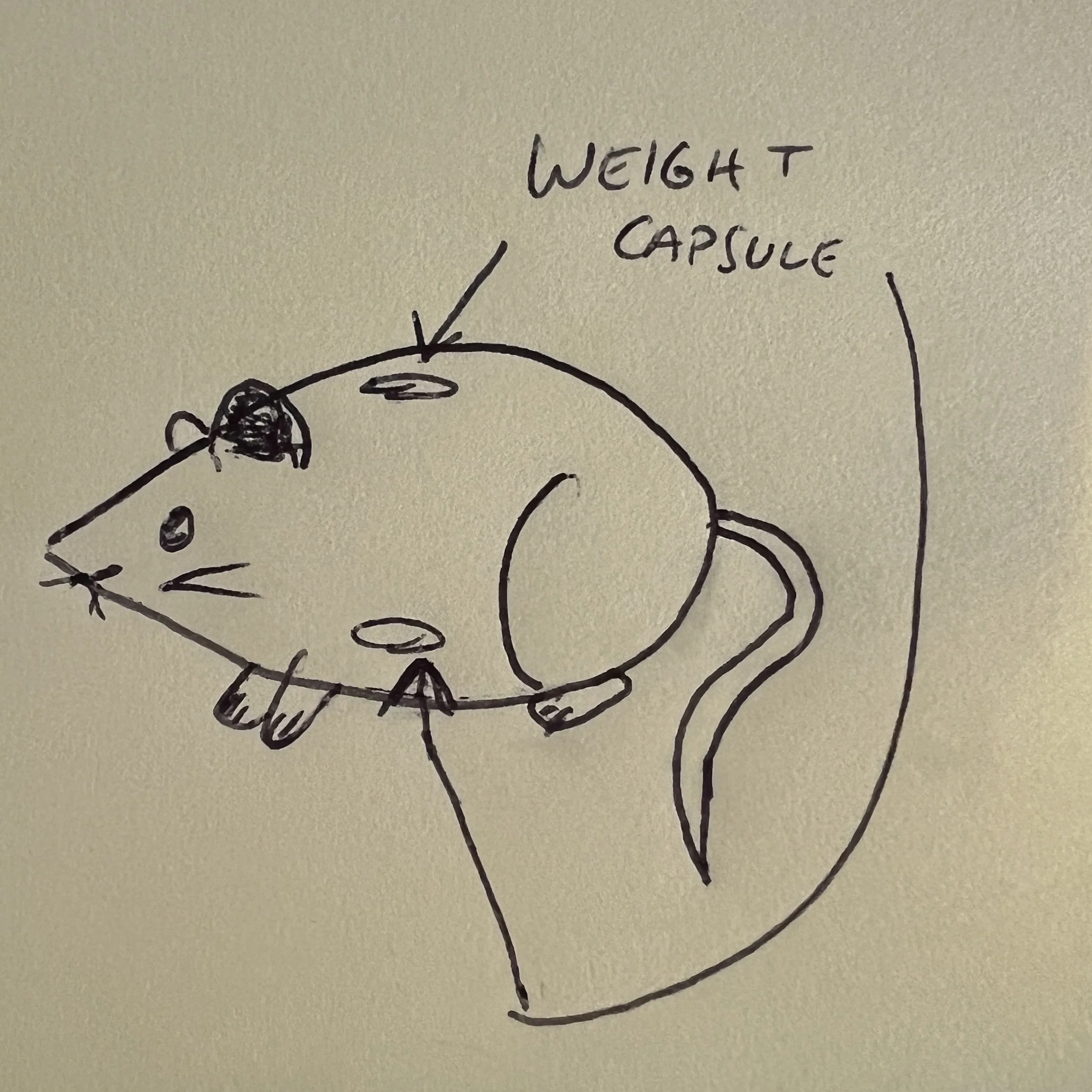Do weighted vests help with weight loss?
How do we solve a question if the answer doesn’t exist? We form a hypothesis, create an experiment, test, and observe results.
That’s exactly what happened in 2017 when a team of researchers in Sweden hypothesized that there is a homeostatic regulation of bodyweight based on loading.
So, the Swedes took some rats, made them obese by increasing their caloric intake, then implanted a capsule into their abdomen or onto their back - the capsule weighed 15% of their bodyweight.
Yes, this is my artwork.
But why rats? Some research uses rats to test theories as rats are very cost-effective and can help us discover mechanisms.
There was also a control group that had an “empty” capsule implanted - this was 3% of their bodyweight. They found that the rats who had the heavier implant reduced their food intake and subsequently lost weight.
When the researchers removed the rats’ osteocytes (cells in bone that act as a sensor) - the weight-reducing effect of the heavier capsule was lost.
The research team had discovered a potential new mechanism for bodyweight regulation - the “gravitostat.”
But you’re not a rat.
And science has to evolve, so we started testing this in humans.
In 2018, a team in North Carolina took 37 people and assigned them to a calorie deficit either with or without weighted vest use. The weighted vest group wore a vest for an average of 6.7 hours per day.
Both groups lost a similar amount of weight with no difference in fat mass, lean mass, or body fat %.
This was a 22 week study which is a pretty solid length of time to discover if we’d see significant changes.
The one upside; the weight vest grew maintained leg power better than the non-weight vest group.
The downside; 25% of the weight vest group (5 out of 20) reported back pain or soreness.
So no benefit to humans, right? Hang on.
One test in humans was by the very same group who discovered the gravitostat theory. In 2020 they took 72 participants and assigned them to either a high-load or low-load group. The high-load group received a weighted vest corresponding to 11% of their bodyweight, the low-load group received a weighted vest that was 1% of their bodyweight. They were told to wear it at for at least 8 hours per day and were disqualified if they deviated by more than 20% (1.6 hours).
The results actually looked pretty good!
Participants wearing the high-load vest lost on average 1.61kg (3.5 lbs) and the low-load vest lost 0.3kg (0.66 lbs) in three weeks. However, 37% of the high-load group reported adverse effects - the most common being musculoskeletal (joint/muscle pain).
But… there are some head scratchers in this study. For example, the researchers said rats who had an increased load ate less food - but according to the food intake questionnaires given in this human study - the participants had no change in intake. Food intake questionnaires are notoriously inaccurate, so take this with a grain of salt.
So let’s say the participants experienced NO change in calorie intake… how did they lose the weight? Surely increased energy expenditure right? Well, researchers tried to measure physical activity using accelerometers but they “broke down and very frequently reset themselves to 0 during the study.”
I don’t know about you, but this is just confusing. So for until further research comes out, I’m putting more stock into the North Carolina study as they tried to control for dietary intake and it was 22 weeks vs the Sweden study’s 3 weeks.
So maybe an effect in humans?
This is how science almost always works. We rarely get definitive answers; the research helps point us to a likely outcome in specific populations. Sometimes we have similar research that can point in opposite directions.
In the future, I’d like to see a long-term study that tracks diet and movement a bit closer. A simple pedometer and instructions for calorie tracking would go a long way to see what’s going on here (if anything).
For now, my recommendation for weight vests:
If you enjoy them, go nuts. They aren’t a silver bullet for weight loss, but they may have unique benefits aligned with the gravitostat theory. If you enjoy using a weighted vest - it won’t harm anything.
It can be an easy way to add load for things like push-ups and pull-ups.
It could be very sport-specific for things like football (added weight of gear).
But if somebody is trying to sell you on it for fat loss, we just don’t have the research to back that.


